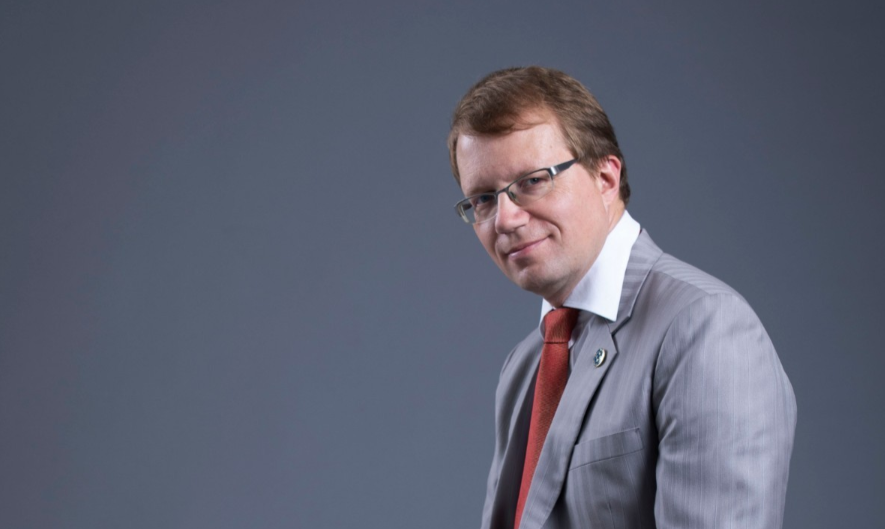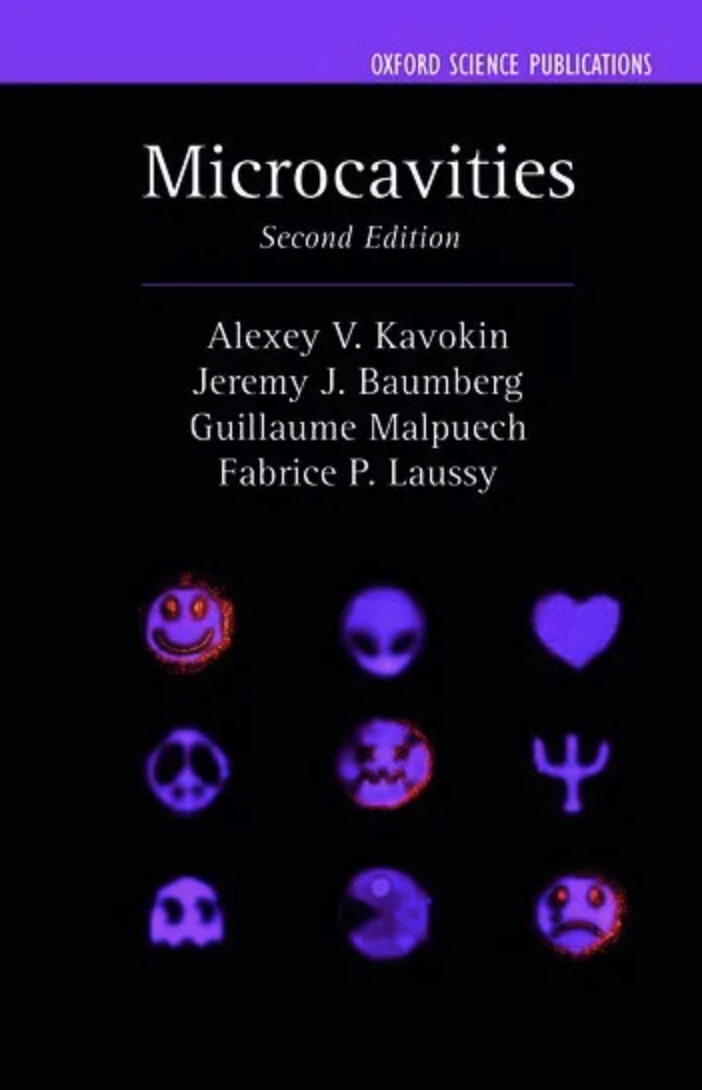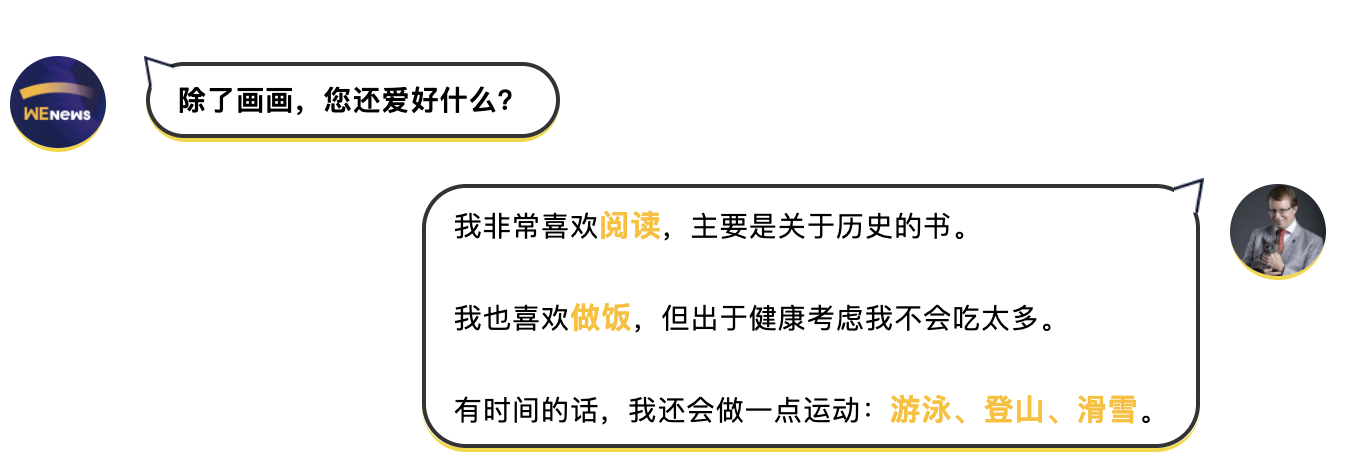ACADEMICS
Xiaoqing Zhou
May 18, 2020
Professor Alexey Kavokin received the Quantum Devices Award for 2020 “for the prediction of room temperature Bose-Einstein condensation of exciton-polaritons, that led to the development of polariton lasers”.

Established in 2000, the Quantum Device Award annually confers scholars pioneering in the field of compound semiconductor devices and quantum nanostructure devices including physics and epitaxial growth. The award ceremony is usually held during the Compound Semiconductor Week (joint venue of ISCS and IPRM), which have either made a major scientific or technological impact in the past 20 years.
To understand the significance of polaritonics, we interviewed Professor Kavokin.

Well-deserved award
——You were awarded for your work on polaritonics. Can you tell us something about polaritons in general? What inspired you to choose the field of polaritonics in the first place?
Kavokin: Polaritonics offers an opportunity to test a wide range of physical theories in a laboratory of a millimeter size. We study processes that take place in black holes and remote galaxies by shining laser beams on small artificial crystal structures. Recently, we have studied experimentally an effect proposed 90 years ago by Erwin Schroedinger (the German Nobel prize winner, one of the fathers of quantum mechanics). Nobody could observe it before! It is very exciting to be able to discover, in a small artificial world, effects that may change the big world.

——To be more specific, you were awarded “for the prediction of room temperature Bose-Einstein condensation of exciton-polaritons, that led to the development of polariton lasers”. How can we get an understanding of what this condensation and the polariton lasers are?
Kavokin: Bose-Einstein condensation is a new phase state of matter predicted by Albert Einstein in 1924-1925 after the works of Satyendra Nath Bose from India. In this phase, a great number of quantum particles, named bosons, occupy a single quantum state. One can imagine millions of cars on a motorway that move with the same speed, accelerate and use breaks simultaneously. A Bose-Einstein condensate behaves like if it would be a single particle even if it is composed of millions of particles.
It may be formed at temperatures lower than a critical one. The effect was discovered experimentally in Li- and Rb-atoms at extremely low temperatures (about one hundred million times less than 1 °K). In the paper from 2003, we have predicted the Bose-Einstein condensation of light-matter quasiparticles named exciton-polaritons at the room temperature [1]. My co-authors of this work are prominent physicists: Guillaume Malpuech did his PhD in my former group in France, now he is a director of research at the centre national de la recherche scientifique (CNRS). Bernard Gil, who is now a director of research of an exceptional class and Honorary Professor at the Saint Petersburg State University, drew our attention to gallium nitride – a promising wide-band gap semiconductor material. Following his intuition, I initiated the research on GaN microcavities, which resulted in the breakthrough of 2007 [2]. We reported the first experimental evidence of the Bose-Einstein condensation at room temperature and demonstrated the world’s first room-temperature polariton laser. Since then, the effect was observed in many semiconductor systems.
[1]"Semiconductor microcavities: towards polariton lasers", Kavokin A, Malpuech G, Gil B, J. Nitride Semicond. Res. 8, 3, 3 (2003)
[2]"Room-temperature polariton lasing in semiconductor microcavities", Christopoulos S, von Hogersthal GBH, Grundy AJD, Lagoudakis PG, Kavokin AV, Baumberg JJ, Christmann G, Butte R, Feltin E, Carlin JF, Grandjean N, Phys. Rev. Lett. 98, 12, 126405 (2007)
——And I noticed that you emphasized this all happens at “room temperature”. Why we need room-temperature Bose-Einstein Condensate and polariton laser that you theoretically predicted and experimentally demonstrated?
Kavokin: Before our work, it was only observed at extremely low temperatures. It was exotic physics. But now, as it is at room temperature, it comes to the everyday life. Now, polariton lasers are coming into play as important components of future quantum computers and quantum communication networks. There are thousands of research works published on this topic and tens of research laboratories are involved in studies of polaritons.
My early works on this topic were published about 20 years ago, but it takes time to confirm the theoretical prediction, demonstrate experimentally the predicted effect and develop a new generation of quantum devices – polariton lasers.Of course I was not alone doing these studies. The progress in polaritonics is a result of many years of research work of hundreds of scientists in Europe, USA, China, Russia, and Japan. 20 years of research on Bose-Einstein condensation and polariton lasing are summerized in our book “Microcavities” [3].

[3] "Microcavities”, Kavokin.A., Baumberg J.J., Malpuech G. and Laussy F.P., 2nd Edition, Oxford University Press (2017)
——You have founded an international research center for polaritonics at Westlake University. What do you want to further explore on polaritons?
Kavokin: I see two main application areas of polaritonics now:
One is for the realization of quantum computers and simulators based on semiconductor crystal structures. This is a new platform for quantum technologies that offers several significant advantages over the existing platforms. It is faster and it is expected to be flexible and cheap, compared to the superconducting platforms used by Google and IBM. Using the polariton platform, China may become a world leader in quantum computing.
Another important application area is the light-induced superconductivity. With the use of polariton condensates, we hope to be able to enhance the critical temperature of superconductivity up to the room temperature (now, it is less than -100 °C in the best cases). This would have a huge economic impact. Energy would be transferred without losses by superconducting cables.
In the next 3-5 years, we shall pursue two main goals: building the polariton platform for quantum computing and demonstrating the light-induced superconductivity. I believe, it is time to bridge the gap between the fundamental research discoveries and industrial applications. I am looking forward to establishing contacts with industrial partners in China.
Science is not all

——Interestingly,your drawings of cats appear in your seminar presentation, in many offices in your center. I heard that the next generation souvenirs of the University will have your cat as a symbol. Does your cat have a name?
Kavokin: I have published a series of books for children where the main character is Saladin, the Cat. The books have been published in various languages. I like drawing, in general; and, when I have lengthy and boring meetings, I always spend time drawing with a black pen on white paper. This is how the most part of my cats appeared.

——Can you tell us what they are about? When did you start the first book? What was your motivation?
Kavokin: I started in 1998 when my first son Nikita was 3 years old. We were living in different countries, and to help him to learn reading I was sending him a page of a new book every day. This is how the first books about Saladin the Cat were written. This Cat likes history very much. He travels in time, visits medieval kingdoms, and solves mysteries of history. Saladin the Cat has a family: he lives in a castle together with a boy named Robin and the Grandma. They support the Cat during all of his adventures. These books are translated into many languages. My books are entertaining, but they also have an educational component. They explain complex things with simple words.
——Do your children love science? Could you give some advice to parents in general, how to inspire their children for science?
Kavokin: My first son is a scientist already. He is doing his PhD in physics in France. My other children study at school. I don’t know what they will become in the future. They like computer games, as many children do. There is a lot of science behind computer games. I hope that when they play they will be learning, too. When I am at home, I read my books to my children, and we like spending time together. When the children see that I am doing something interesting, they want to join, this is how they start learning.

——What are your hobbies? What do you enjoy doing during vacation or weekends?
Kavokin: I like reading very much. Mostly, books about history. I also like cooking, but I should not eat too much as I want to keep fit. I am doing some sports when I have time: cycling, swimming, mountain skiing. And I like drawing, writing stories, and playing board games.
We look forward to Professor Kavokin leading the international research center for polaritonics at Westlake University to further achievements. The labs will be fully functional soon. We also cannot wait to see the Cats on Westlake University souvenirs and his books for children about quantum computers and racing cars.
5月18日,国际化合物半导体大会量子器件奖正式公布:经提名、评选,西湖大学理学院讲席教授Alexey Kavokin获得了2020年“量子器件奖”(The Quantum Devices Award),表彰他成功预测了极化激元在室温下的玻色-爱因斯坦凝聚,促生了极化激元激光的发展。

“量子器件奖”创立于1986年,每年评选出一位或数位研究者,表彰他们在化合物半导体器件和量子纳米结构器件(包括物理学和晶体生长)的先驱性贡献,近20年来已形成较大的科学和技术影响力。
为了理解极化激元的重要性,我们采访了Kavokin教授。

为什么是他
Question:能给我们科普一下什么是“极化激元”么?
Kavokin: 极化激元就像是一个实验室,只不过这个实验室的大小是微米量级的,它真的极小,但我们能在里面验证各种物理理论——当我们把一束激光打进一个微小的晶体结构里,我们甚至可以研究在黑洞和遥远星系里发生了什么。
最近,我们正在实验研究薛定谔(量子力学创始人之一,诺贝尔奖获得者)90年前提出的一种效应,在此之前还没人能观察到。在如此微小的世界里发现能影响浩瀚宇宙的效应,这是多么令人激动啊!

实验观测到的极化激元
(图片来自合作团队)
Question:我们该怎么理解“玻色-爱因斯坦凝聚”和“极化激元激光”?
Kavokin: 这要追溯到上世纪20年代。1924年到1925年之间,阿尔伯特·爱因斯坦在萨特延德拉·纳特·玻色的研究基础上,预测了物质除了固态、液态和气态,还有一种新的物态——大量的量子粒子(玻色子)“凝聚”到同一个量子状态。
换句话说,几百万个粒子表现得就像它们是一个粒子。我们可以想象,一条高速公路上成千上万的汽车都以同样的速度前进,同步加速,同步刹车。这种新的物态就是“玻色-爱因斯坦凝聚”。
不过,要达到玻色-爱因斯坦凝聚,一般需要在很低的温度下。比如人类首次在实验中观察到这种效应,就是在极其低温的铷原子气体中,当时的温度比绝对零度高了不到百万分之一度。
我们在2003年预测,极化激元在室温下就能达成玻色-爱因斯坦凝聚[1]。当时这项工作的合著作者现在都是著名的物理学家:其中一位Guillaume Malpuech,是现任法国国家科研中心(CNRS)院长,CNRS是法国最大的科学技术研究机构;另一位Bernard Gil也是CNRS的特级教授(Director of Research of an Exceptional class)、圣彼得堡国立大学荣誉教授,是他引发了我们对氮化镓这种半导体材料的兴趣。顺着他的直觉,我开始研究氮化镓微型腔。
最终,我们在2007年获得了实验上的突破,在室温下达到了玻色-爱因斯坦凝聚,并且展示世界上首台室温下的极化激元激光[2]。之后,人们在很多半导体系统里都观察到了这种效应。
[1]"Semiconductor microcavities: towards polariton lasers", Kavokin A, Malpuech G, Gil B, J. Nitride Semicond. Res. 8, 3, 3 (2003)
[2]"Room-temperature polariton lasing in semiconductor microcavities", Christopoulos S, von Hogersthal GBH, Grundy AJD, Lagoudakis PG, Kavokin AV, Baumberg JJ, Christmann G, Butte R, Feltin E, Carlin JF, Grandjean N, Phys. Rev. Lett. 98, 12, 126405 (2007)
Question: 您刚才强调,您在理论预测和实验中证实的效应是发生在“室温条件下”,为什么“室温下”很关键?
Kavokin: 如果它们只能存在于极低温度下,我们视它们为一种奇异的物理现象。而我们的研究表明,它们可以存在于在室温下,那它们就能进入日常生活。正因为如此,极化激元激光如今已经开始作为未来量子计算机和量子通信网络的重要部件。
我在该领域获得第一项成果是在20年前了,但检查理论预测、实验验证、开发新一代量子器件(极化激元激光)都需要时间。我们在《微型腔》(下图)一书中总结了20年以来对玻色-爱因斯坦凝聚和极化激元激光的研究[3]。

当然,从事这方面研究的远远不止我一人,极化激元研究的发展,离不开数百位分布在欧洲、美国、中国、俄罗斯、日本的科学家这么多年来的努力。当今在这一领域相关的研究成果论文有好几千篇,全世界几十个实验室都在做。
[3] "Microcavities”, Kavokin.A., Baumberg J.J., Malpuech G. and Laussy F.P., 2nd Edition, Oxford University Press (2017)
Question: 您在西湖大学创建了一个国际极化激元研究中心,您认为这个领域有什么是值得继续探究的?
Kavokin: 我认为有两个主要的应用方向:
一是基于半导体晶体结构,来实现量子计算机和量子模拟机。和谷歌、IBM现有的超导量子技术平台相比,用极化激元实现的量子平台有几个明显的优势:更快、更灵活、费用更低,中国或许能成为量子计算的全球引领。
另一个应用是光致超导。利用极化激元的凝聚,我们能够提高超导的临界温度,现在能做到最好的是零下100摄氏度,以后或许还能在室温形成超导。超导能节省能耗,这会是一个重大的经济影响。
接下来的3~5年间,国际极化激元中心的科研也正是朝着以上这两个目标:建立一个极化激元量子计算平台、实现光致超导。我认为,现在是时候在基础研究和工业应用之间架起一座桥了,我很期待在中国和工业界开展合作。
科学并不是他的全部
画画、桌游、滑雪……对Kavokin教授来说,生活丰满而有趣,而科学只是其中一部分罢了。既然如此,聊完科学,我们来说说别的。







彩蛋来了
目前,在Alexey Kavokin教授领衔的西湖大学国际极化激元中心,数个在建的实验室即将开始全面运行;而他写给孩子们的科学绘本——中文版《安可乐和量子计算机》、《安可乐和赛车》将在今年暑假由浙江教育出版社出版;还有,以那只名叫萨拉丁的猫为主题的西湖文创系列,也已经在酝酿中。

让我们期待,极化激元实验室获得更多科研进展。
也同时期待,这些科研上的突破,像绘本和文创一样,走入我们寻常的生活中。